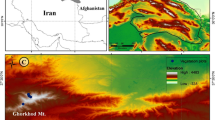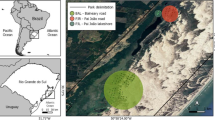Abstract
In Eastern South America, high altitude grasslands represent a mountain system that has a high number of endemic species. However, studies on the ecology of plant communities in these environments remain scarce. We aimed to evaluate the patterns of biodiversity and structure of plant communities from rocky outcrops in high altitude grasslands of three areas at the Caparaó National Park, southeastern Brazil, by sampling 300 randomly distributed plots. Then, we compared the floristic composition, relative abundance, and biological and vegetation spectra among areas. We classified species as endemic and non-endemic and verified the occurrence of endangered species. Species richness was evaluated by rarefaction analysis on the sampling units. The importance value and species abundance distribution (SAD) models were assessed. We also performed an indicator species analysis. We sampled 58 species belonging to 49 genera and 32 families. The number of species decreased with increasing altitude, with significant differences being observed among areas regarding richness, abundance, and cover. Of the total number of species, 10 are endemic to the Caparaó National Park and 17 are listed on the Brazilian Red List of endangered species. The dominant families on all peaks were Asteraceae and Poaceae. The SAD models showed lognormal and geometric distributions, corroborating the fact that 10 species that were common to all three areas were also the most dominant ones in the communities and showed the highest importance values, which ranged between 35% and 60%. Indicator species analysis revealed that 28 species (48.27%) were indicators. Of these, 42.85% had maximum specificity, meaning that they occurred only in one area. Thus, the number of species per life form ratio was similar among areas, yet vegetation spectra differed, especially for hemicryptophytes. The altimetric difference among the areas showed to be a very important driver in the community assembly, influencing the evaluated variables, however, other drivers as soil depth, slope and water could also influence the community structure on a smaller and local spatial scale.
Similar content being viewed by others
References
Alroy J (2015) The hypothesis that niche space is multidimensional helps to explain how numerous species can coexist despite interacting strongly. Science Advance 1: 1–8. https://doi.org/10.1126/sciadv.1500082
Angelo CL, Daehler CC (2013) Upward expansion of fireadapted grasses along a warming tropical elevation gradient. Ecography 36: 551–559. https://doi.org/10.1111/j.1600-0587.2012.07754.x
Assis MV, Mattos EA (2016) Vulnerability of Brazilian highaltitude grasslands to climate change. Oecologia Australis 20: 24–36. (In Portuguese) https://doi.org/10.4257/oeco.2016.2002.03
Bakker JD (2008) Increasing the utility of Indicator Species Analysis. Journal of Applied Ecology 45: 1829–1835. https://doi.org/10.1111/j.1365-2664.2008.01571.x
Barbosa NPU, Fernandes GW, Sanchez-Azofeifa A (2015) A relict species restricted to a quartzitic mountain in tropical America: an example of microrefugium? Acta Botânica Brasilica 29: 299–309. https://doi.org/10.1590/0102-33062014abb3731
Barthlott W, Mutke J, Rafiqpoor D, et al. (2005) Global centers of vascular plant diversity. Nova Acta Leopoldina 342: 61–83.
Benites VM, Schaefer CEGR, Simas, FNB, et al. (2007) Soils associated with rock outcrops in the Brazilian mountain ranges Mantiqueira and Espinhaço. Revista Brasileira de Botânica 30: 569–577. https://doi.org/10.1590/S0100-84042007000400003
Bitencourt C, Rapini A, Damascena dos Santos L, et al. (2016) The worrying future of the endemic flora of a tropical mountain range under climate change. Flora 218: 1–10. https://doi.org/10.1016/j.flora.2015.11.001
Braun-Blanquet J (1979) Phytosociology. Basis for the study of plant communities. Ed. Blume, Madrid. Brazil. Ministry of Environment. Ordinance 43 of January 31th, 2014. Official Gazette of the Federative Republic of Brazil, Brasília, DF. (https://doi.org/www.mma.gov.br, accessed on 2017-06-08) (In Portuguese)
Caiafa AN, Silva AF (2005) Floristic composition of a “campo de altitude“ in the Serra do Brigadeiro State Park, Minas Gerais-Brazil. Rodriguésia 56: 163–173. (In Portuguese)
Caiafa AN, Silva AF (2007) Structural analysis of the vegetation on a highland granitic rock outcrop in Southeast Brazil. Revista Brasileira de Botânica 30 (4): 657–664. https://doi.org/10.1590/S0100-84042007000400010
Carmo FF, Campos IC, Jacobi CM (2016) Effects of fine-scale surface heterogeneity on rock outcrop plant community structure. Journal of Vegetation Science 27: 50–59. https://doi.org/10.1111/jvs.12342
Chao A, Colwell RK, Lin CW, Gotelli NJ (2009) Sufficient sampling for asymptotic minimum species richness estimators. Ecology 90: 1125–1133. https://doi.org/10.1890/07-2147.1
Chao A, Gotelli NJ, Hsieh TC, et al. (2014) Rarefaction and extrapolation with hill numbers: a framework for sampling and estimation in species diversity studies. Ecological monographs 84: 45–67. https://doi.org/10.1890/13-0133.1
Colwell RK, Chao A, Gotelli NJ, et al. (2012) Models and estimators linking individual-based and sample-based rarefaction, extrapolation, and comparison of assemblages. Journal of Plant Ecology 5: 3–21. https://doi.org/10.1093/jpe/rtr044
Colwell RK, Brehm G, Cardelús CL, et al. (2008) Global warming, elevational range shifts, and lowland biotic attrition in the wet tropics. Science 322: 258–261. https://doi.org/10.1126/science.1162547
Costa NO, Cielo-Filho R (2012) Floristic biological spectra of rock outcrops and wet grasslands differ between themselves and in relation to the Raunkiaer’s normal biological spectrum. Revista do Instituto de Floresta 24: 159–171. (In Portuguese)
Costa NO, Cielo-Filho R, Pastore JA, et al. (2011) Floristic characterization of vegetation on rocky outcrop in the Itapeva Experimental Station, SP, and comparison with areas of rocky grasslands and high-altitude grasslands. Revista do Instituto Florestal 23: 81–108. (In Portuguese)
Cuello NI, Cleef AM, Aymard G (2010) Phytogeography of the vascular páramo flora of Ramal de Guaramacal (Andes, Venezuela) and its ties to other páramo floras. Anales del Jardín Botánico de Madrid 67: 177–193. https://doi.org/10.3989/ajbm.2253
De Cáceres M, Legendre P, Moretti M (2010) Improving indicator species analysis by combining groups of sites. Oikos 119: 1674–1684. https://doi.org/10.1111/j.1600-0706.2010.18334.x
De Cáceres M, Jansen F (2016) Relationship between Species and Groups of Sites. Package ‘indicspecies’. pp 1–31.
Dufrêne M, Legendre P (1997) Species assemblages and indicator species: the need for a flexible asymmetrical approach. Ecological Monographs 67: 345–366. https://doi.org/10.1890/0012-9615
Dludlu MN, Chimphango SBM, Stirton CH, Muasya AM (2017) Distinct edaphic habitats are occupied by discrete legume assemblages with unique indicator species in the Cape Peninsula of South Africa. Journal of Plant Ecology 1–13. https://doi.org/10.1093/jpe/rtx027
EMBRAPA-Empresa Brasileira de Pesquisa Agropecuária (1997) Manual de métodos de análises de solo. 2.ed. Rio de Janeiro, Ministério da Agricultura e do Abastecimento. p 212. (In Portuguese)
Fattorini S, Rigal F, Cardoso P, Borges PAV (2016) Using species abundance distribution models and diversity indices for biogeographical analyses. Acta Oecologica 70: 21–28. https://doi.org/10.1016/j.actao.2015.11.003
Fernandes GW (2016) The Megadiverse Rupestrian Grassland. In: Ecology and Conservation of Mountaintop Grasslands in Brazil. Belo Horizonte, Minas Gerais. pp 3–14.
Ferreira FC, Petrere M (2008) Comments about some species abundance patterns: classic, neutral, and niche partitioning models. Brazilian Journal Biology 68: 1003–1012. https://doi.org/10.1590/S1519-69842008000500008
Gröger A, Huber O (2007) Rock outcrop habitats in the Venezuelan Guayana lowlands: main vegetation types and floristic components. Revista Brasileira de Botânica 30: 599–609. https://doi.org/10.1590/S0100-84042007000400006
Hernández Z, Monasterio M (2006) Functional diversity of wetland vegetation in the high-Andean Páramo, Venezuela. Land Use Change and Mountain. p 124. ICMBIO [online] Disponível em: <https://doi.org/www.icmbio.gov.br, accessed on 2015-12-08. (In Portuguese)
Jacobi CM, Carmo FF (2011) Life-forms, pollination and seed dispersal syndromes in plant communities on ironstone outcrops, SE Brazil. Acta Botânica Brasilica 25: 395–412. https://doi.org/10.1590/S0102-33062011000200016
Körner C, Ohsawa M, Spehn E, et al. (2005) Mountain Systems. In: Hassan R, Scholes R, Ash N (eds.) Ecosystems and Human Well-being: Current State and Trends, Volume 1. Washington DC, Island Press. pp 681–716.
Leão TCC, Fonseca CR, Peres CA, Tabarelli C (2014) Predicting extinction risk of brazilian atlantic forest angiosperms. Conservation Biology 28: 1349–1359. https://doi.org/10.1111/cobi.12286
Legendre P, Legendre L (2012) Numerical Ecology. Third English edition, Elsevier Science, Amsterdam.
Le Stradic S, Buisson E, Fernandes GW (2015) Vegetation composition and structure of some neotropical mountain grasslands in Brazil. Journal of Mountain Science 12: 864–877. https://doi.org/10.1007/s11629-013-2866-3
Londoño C, Cleef A, Madrinán S (2014) Angiosperm flora and biogeography of the páramo region of Colombia, Northern Andes. Flora 209: 81–87. https://doi.org/10.1016/j.flora.2013.11.006
Magurran AE (2004) Measuring biological diversity. Oxford, Blackwell Science. p 256.
McCain CM, Grytnes JA (2010) Elevational gradients in species richness. Encylcopedia Life Science 15: 1–10. https://doi.org/10.1002/9780470015902.a0022548
McGill B J, Etienne RS, Gray JS, et al. (2007) Species abundance distributions: moving beyond single prediction theories to integration within an ecological framework. Ecology Letters 10: 995–1015. https://doi.org/10.1111/j.1461-0248.2007.01094.x
Neri AV, Borges GRA, Meira Neto JA, et al. (2016) Soil and altitude drives diversity and functioning of Brazilian Páramos (campo de altitude). Journal of Plant Ecology 10(5):731–743. https://doi.org/10.1093/jpe/rtw088
Nunes JA, Schaefer CEGR, Ferreira-Junior WG, et al. (2015) Soil-vegetation relationships on a banded ironstone ‘island’, Carajás Plateau, Brazilian Eastern Amazonia. Anais da Academia Brasileira de Ciências 87: 2097–2110. https://doi.org/10.1590/0001-376520152014-0106
Oksanen J, Blanchet FG, Kindt R, et al. (2013) Vegan: community ecology package. R package version 2.0-7.
Porembski S (2007) Tropical inselbergs: habitats types, adaptive strategies and diversity patterns. Revista Brasileira de Botânica 30: 579–586. https://doi.org/10.1590/S0100-84042007000400004
R Core Team (2014) R: A language and environment for statistical computing. R Foundation for Statistical Computing, Vienna, Austria. ISBN 3-900051-07-0. Available online: https://doi.org/www.R-project.org, accessed on 2015-10-08.
Raunkiaer C (1934) The life forms of plants and statistical geography. Claredon, Oxford. p 632.
Ribeiro KT, Medina BMO, Scarano FR (2007) Species composition and biogeographic relations of the rock outcrop flora on the high plateau of Itatiaia, SE-Brazil. Revista Brasileira de Botânica 30: 623–639. https://doi.org/10.1590/S0100-84042007000400008
Ricotta C, Carboni M, Acosta ATR (2015) Let the concept of indicator species be functional! Journal of Vegetation Science 1–9. https://doi.org/10.111/jvs.12291
Rull V (2005) Vegetation and environmental constancy in the Neotropical Guayana Highlands during the last 6000 years? Review of Paleobotany and Palynology 135: 205–222. https://doi.org/10.1016/j.revpalbo.2005.03.008
Sarmiento G (1986) Ecologically crucial features of climate in high tropical mountains. In: Vuilleumier F, Monasterio M (eds.), High Altitude Tropical Biogeography. Oxford University Press, Oxford. pp 135–156.
Safford HD (1999a) Brazilian Páramos I. An introduction to the physical environment and vegetation of the campos de altitude. Journal of Biogeography 26: 693–712. https://doi.org/10.1046/j.1365-2699.1999.00313.x
Safford HD (1999b) Brazilian Páramos II. Macro-and mesoclimate of the campos de altitude and affinities with high mountain climates of the tropical Andes and Costa Rica. Journal of Biogeography 26: 713–737. https://doi.org/10.1046/j.1365-2699.1999.00312.x
Safford HD (2001) Brazilian Páramos III. Patterns and rates of post fire regeneration in the campos de altitude. Biotropica 33: 282–302. https://doi.org/10.1646/0006-3606
Safford (2007) Brazilian Páramos IV. Pytogeography of the campos de altitude. Journal of Biogeography 34: 1701–1722. https://doi.org/10.1111/j.1365-2699.2007.01732.x
Safford HD, Martinelli G (2000) Southeast Brazil. In: Porembski S, Barthlott W (eds.), Inselbergs. Heidelberg, Ecological Studies, Springer-Verlag 146: 339–389. Schaefer CEGR
Corrêa GR, Candido HG, et al. (2016) The physical environment of rupestrian grasslands (campos rupestres) in Brazil: geological, geomorphological and pedological characteristics, and interplays. In: Fernandes GW (ed.), Ecology and Conservation of Mountaintop Grasslands in Brazil. Springer International Publishing AG Switzerland. pp 15–53.
Silveira FAO, Negreiros D, Barbosa NPU, et al. (2015) Ecology and evolution of plant diversity in the endangered campo rupestre: a neglected conservation priority. Plant Soil 403: 129–152. https://doi.org/10.1007/s11104-015-2637-8
Sklenář P, Balslev H (2005) Superpáramo plant species diversity and phytogeography in Ecuador FLOR 200: 416–433. https://doi.org/10.1016/j.flora.2004.12.006
Spehn EM, Liberman M, Körner C (2006) Land use change and mountain biodiversity. CRC Press. Boca Raton 34: 21–25.
Sugihara G (1980) Minimal community structure: an explanation of species abundance patterns. The American Naturalist 116: 770–787. https://doi.org/10.1086/283669
Tinti BV, Schaefer CERG, Nunes JA, et al. (2015) Plant diversity on granite/gneiss rock outcrop at Pedra do Pato, Serra do Brigadeiro State Park, Brazil. Check List 11: 1780. https://doi.org/10.15560/11.5.1780
Vegas-Vilarrúbia T, Nogué S, Rull V (2012). Global warming, habitat shifts and potential refugia for biodiversity conservation in the neotropical Guayana Highlands. Biological Conservation 152: 159–168. https://doi.org/10.1016/j.biocon.2012.03.036
Acknowledgment
The authors thank the Caparaó National Park and the Brazilian Coordination for the Improvement of Higher Education Personnel (CAPES) for granting a scholarship to the first author. Conselho Nacional de Desenvolvimento Científico e Tecnológico (CNPq; 206814/2014-3, Postdoctorate scholarship of A.V.N.); Dr.Michel Barros Faria for helping with the map and Dr. Ian Michael Trotter for helping with the figures.
Author information
Authors and Affiliations
Corresponding author
Electronic supplementary material
Rights and permissions
About this article
Cite this article
Campos, P.V., Villa, P.M., Nunes, J.A. et al. Plant diversity and community structure of Brazilian Páramos. J. Mt. Sci. 15, 1186–1198 (2018). https://doi.org/10.1007/s11629-017-4674-7
Received:
Revised:
Accepted:
Published:
Issue Date:
DOI: https://doi.org/10.1007/s11629-017-4674-7




